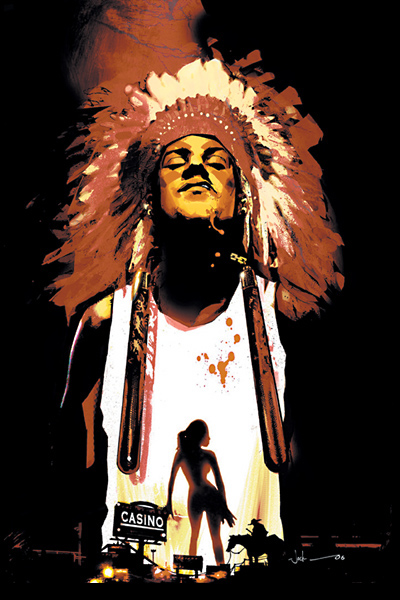

A mixed-blood Cherokee named Phill (Phyllis?) responds to SCALPED: Another Comic Book Gets Indians Wrong:
Some excerpts with my responses:
>> My commentary here is a response to the general idea expressed by the commentary from the critic at Bluecorncomics.com. I don't particularly disagree with his interpretation/response; the whole idea of reviewing and critiquing is to say what you feel. But I think, based on the exchange depicted on the page, there is a problem that I sort of fear as I move into Native/Indigenous studies: why should ANY depiction of Native peoples be considered a reflection on ALL Native peoples? <<
In other words, why should Native ever protest any Native stereotype? Because what harm can any single example of stereotyping do? Is someone going to discriminate against an Indian because he read an unflattering portrayal in SCALPED?
So why do Indian leaders, activists, and academics spend so much time combating negative stereotypes? Why do they claim stereotypes are the worst problem facing Indians? Have they missed all the poverty, crime, and substance abuse on reservations?
The answer is that each particular single of stereotyping contributes to the overall impression held by society. It has a cumulative effect. As a result of millions of portrayals of Indians as savages, the public thinks—here comes a shocker—Indians are savages.
And this influences every aspect of an Indian's relationship with the United States. It underlies the treatment Indians receive from governments, businesses, churches, Hollywood, and the public. One could point to many examples—and I do point to them in my Stereotype of the Month contest.
A few of the many quotes at The Harm of Native Stereotyping: Facts and Evidence may help make the point:
More so than any other group, American Indians are portrayed in popular culture as a people of the past, and as a result, the material conditions of the lives of Native peoples today are largely ignored.
America prefers Tonto-esque "good Indians" located in the far off past where Indian rebellion can be ideologically managed. Real Indians with real culture and real grievances are generally taboo.
Media image is especially crucial because it is that image that looms large as non-Indians decide the fate of Indian people. If non-Indian decision-makers continue to view native people as savage survivors or happy hunters on the way to extinction, the policy is different than it would be if decision-makers saw beyond the stereotype.
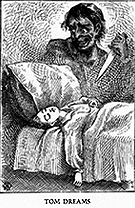
We can't change the overall impression by waving a magic wand. We can only change it by educating in general and pointing out errors and omissions in particular. I don't expect writer Jason Aaron to change his stereotypical approach to Indians—but if fans learn to think critically about the comics they're reading, I've done my job.
>> I have twice (or maybe thrice) made the comparison to the Sopranos here. I think that's apt. I personally LOVED the Sopranos (even the ending that bothered so many fans that the complaints crashed HBO's website three times the night it aired). I found most of the characters compelling, and while the situations were gritty, sometimes way-over-the-top, and certainly less-than-positive depictions of Italian Americans, the show pushed artistic bounds and entertained while making an intricate, engaging argument. <<
I love The Sopranos too. Which is why I'd say something like, "I know the Sopranos, and SCALPED, you're no Sopranos." I covered this point in my critique when I wrote to Jason Aaron:
So far, SCALPED seems more like Scarface, Pulp Fiction, or The Godfather than The Sopranos. It's a more extreme look at Indians than The Sopranos was at Italians. Only about half the Sopranos episodes featured mob killings or violence, while SCALPED #1 was drenched in these things.
>> Other than within the program (through the Italian American character who plays the otherwise forgettable therapist who sees Dr. Melphi, Tony Soprano's therapist), there is very little backlash from the Italian American community about the Sopranos. <<
Yes...1) Because The Sopranos isn't nearly as bad as SCALPED, and 2) because Italians don't face the same 500-plus years of racism and stereotyping that assails Indians.
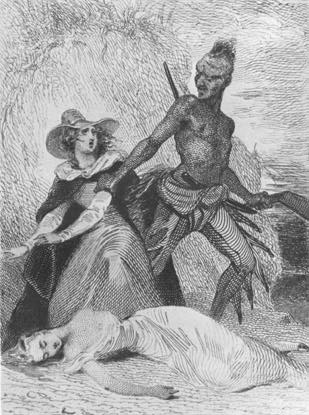
Rehashing Leonard Peltier
>> But my concern is that as a Native creator, the reviewer from BlueCorn was just too hard on SCALPED early on. I've done extensive research on Leonard Peltier, and as such I know that there has, indeed, been a spotlight on violence involving reservation land and policies. <<
I covered this in my critique too:
Trouble is, that was 30 years ago. Tribal governments are much cleaner now because anyone with a cellphone, copy machine, or website can expose their flaws. Indians do use technology, believe it or not, although you wouldn't knows it from SCALPED. This series reads as if it was set in the 1970s—as if Aaron wanted to do a Quentin Tarantino version of Thunderheart.
>> I also know, as a fan of both comic books and crime dramas that the genre demands a certain handling of violence and "grit" as I'm going to call it right now. In that sense, what *I* saw in the first issue of SCALPED was a cabal of tribal criminals acting like criminals. <<
Genres don't "demand" anything. There's a range of blood and violence in every drama involving crime from The Lion King to Law & Order to The Bourne Identity to The Sopranos to Kill Bill Vol. 1. How much blood and violence to include is entirely the creators' choice. In no sense is it a "demand" that must be fulfilled or else.
Is there no other way to do SCALPED?
>> I would argue that to craft SCALPED any other way would be wrong. There's no reason to make a Native criminal somehow noble, and in fact I think that would do harm to popular understanding of what life on the reservation is like. <<
Who said to make the Native criminals "noble"? Not me. My critique covered this point too:
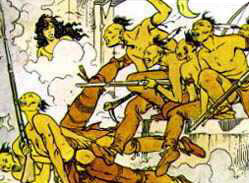
Red Crow, the tribal boss ("leader" isn't the right word), describes himself as "the president of the Oglala tribal council...as well as sheriff of the tribal police force, chairman of the Prairie Rose planning committee, treasurer of the highway safety program...and managing director of this here brand-spankin' new casino." One or two tribes may have a "Godfather" like Red Crow in charge, but the other 560 federally recognized tribes don't. Writer Aaron has taken the worst possible scenario and presented it as the norm.
How evil is Red Crow? When we first meet him, there's a corpse lying in a pool of blood next to his desk. Not only does Red Crow leave bodies lying about, he's killed and scalped the man himself.
Phill heads for her conclusion:
>> I don't think we should ever treat some segment of the population as "off limits" as fodder for popular culture just because we're afraid that trying to depict something stylized but realistic using elements of that culture. <<
That's funny considering I've devoted the last decade to publishing PEACE PARTY, my own Native-themed comic book. It's a crime drama in the sense that it presents a lot of crimes—several attempted murders in the first two issues alone. The difference is, PEACE PARTY is realistic and SCALPED isn't.
>> Until we can accept that any of us can be good or bad, and as such any of us can be depicted as good or bad, I don't know if we're really making progress or just playing "nice" with each other. <<
PEACE PARTY portrays several of its Indians negatively. There are Indians who commit crimes...get drunk...sell out their fellow Indians...prey on tourists...and think white people smell. What PEACE PARTY doesn't portray is 90% of its Indian characters as criminals, thugs, and lowlifes. Because that would be unrealistic.
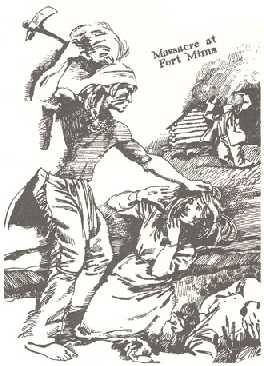
That's the crux of the problem right there. Phill thinks SCALPED is "realistic," but it isn't. As I wrote in my review:
Let me reiterate the key point: To portray Indians worse than the reality isn't "realistic." It's a textbook example of unrealistic. Since it reinforces a thousand previous portrayals of Indians as drunks, savages, and killers, it's stereotypical as well as unrealistic.
Related links
Comic books featuring Indians
|
. . . |

|
All material © copyright its original owners, except where noted.
Original text and pictures © copyright 2008 by Robert Schmidt.
Copyrighted material is posted under the Fair Use provision of the Copyright Act,
which allows copying for nonprofit educational uses including criticism and commentary.
Comments sent to the publisher become the property of Blue Corn Comics
and may be used in other postings without permission.